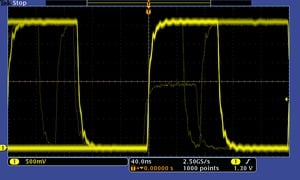
Contact us
Call
Call us at
Available 6:00 AM – 5:00 PM (PST) Business Days
Download
Download Manuals, Datasheets, Software and more:
Feedback
MSO3000 / DPO3000 Mixed Signal Oscilloscopes - Datasheet
MSO3000 / DPO3000 Series Datasheet. (This series has been replaced by MDO3000 Series.)
The products on this datasheet are no longer being sold by Tektronix.
View Tektronix Encore for reconditioned test equipment.
Check support and warranty status for these products.
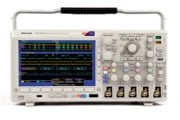
MSO3000 / DPO3000 Series Datasheet. (This series has been replaced by MDO3000 Series.)
Replaced by MDO3000 Series.
*
With the MSO/DPO3000 mixed signal oscilloscope series, you can analyze up to 20 analog and digital signals with a single instrument to quickly find and diagnose problems in complex designs. Bandwidths up to 500 MHz and a minimum of 5x oversampling on all channels ensure you have the performance you need for many of today's mainstream applications. To capture long windows of signal activity while maintaining fine timing resolution, the MSO/DPO3000 offers a deep record length of 5 M points standard on all channels.
Key performance specifications
- 500, 300, 100 MHz bandwidth models
- Bandwidth is upgradable (up to 500 MHz)
- 2 and 4 analog channel models
- 2.5 GS/s sample rate on all channels
- 5 mega-point record length on all channels
- >50,000 wfm/s maximum waveform capture rate
- Suite of advanced triggers
Key features
- Wave Inspector® Controls provide easy navigation and automated search of waveform data
- 29 automated measurements, and FFT analysis for simplified waveform analysis
- 16 digital channels (MSO series)
- Mixed signal design and analysis (MSO series)
- Automated triggering, decode, and search on parallel buses
- Multichannel setup and hold triggering
- MagniVu™ high-speed acquisition provides 121.2 ps fine timing resolution on digital channels
- Optional serial triggering and analysis - automated serial triggering, decode, and search options for I2C, SPI, CAN, LIN, RS-232/422/485/UART, and I2S/LJ/RJ/TDM
- TekVPI® probe interface supports active, differential, and current probes for automatic scaling and units
- 9 in. (229 mm) WVGA widescreen color display
- Small footprint and lightweight – Only 5.8 in. (147 mm) deep and 9 lb. (4 kg)
Connectivity
- USB 2.0 host port on both the front panel and rear panel for quick and easy data storage, printing, and connecting a USB keyboard
- USB 2.0 device port on the rear panel for easy connection to a PC or direct printing to a PictBridge®-compatible printer
- Integrated 10/100 Ethernet port for network connection and video out port to export the oscilloscope display to a monitor or projector
Optional application support
- Power analysis
- HDTV and custom video analysis
Feature-rich tools for debugging mixed signal designs
With Wave Inspector® controls for rapid waveform navigation, automated serial and parallel bus analysis, and automated power analysis – your Tektronix oscilloscope provides the feature-rich tools you need to simplify and speed debug of your complex design.
Comprehensive features speed every stage of debug
These oscilloscopes offer a robust set of features to speed every stage of debugging your design – from quickly discovering an anomaly and capturing it, to searching your waveform record for the event and analyzing its characteristics and your device’s behavior.
Discover
To debug a design problem, first you must know it exists. Every design engineer spends time looking for problems in their design, a time-consuming and frustrating task without the right debug tools.
The industry’s most complete visualization of signals provides fast insight into the real operation of your device. A fast waveform capture rate – greater than 340,000 waveforms per second with FastAcq® – enables you to see glitches and other infrequent transients within seconds, revealing the true nature of device faults. A digital phosphor display with color- and intensity-grading shows the history of a signal’s activity by using color or intensity in areas of the signal that occur more frequently, providing a visual display of just how often anomalies occur.

Discover ‒ Digital phosphor technology with FastAcq enables greater than 340,000 wfms/s waveform capture rate and real-time color-intensity grading.
Capture
Discovering a device fault is only the first step. Next, you must capture the event of interest to identify root cause.
The MSO/DPO3000 Series provides a complete set of triggers – including runt, logic, pulse width/glitch, setup/hold violation, serial packet, and parallel data – to help quickly find your event. With up to a 5 Mpoint record length, you can capture many events of interest, even thousands of serial packets, in a single acquisition for further analysis while maintaining high resolution to zoom in on fine signal details.
From triggering on specific packet content to automatic decode in multiple data formats, the MSO/DPO3000 Series provides integrated support for the industry’s broadest range of serial buses – I2C, SPI, MIL-STD-1553, CAN, LIN, FlexRay, RS-232/422/485/UART, and I2S/LJ/RJ/TDM. The ability to decode up to two serial and/or parallel buses simultaneously means you gain insight into system-level problems quickly.
To further help troubleshoot system-level interactions in complex embedded systems, the oscilloscope offers 16 digital channels in addition to its analog channels. Since the digital channels are fully integrated into the oscilloscope, you can trigger across all input channels, automatically time-correlating all analog, digital, and serial signals. The MagniVu™ high-speed acquisition enables you to acquire fine signal detail around the trigger point for precision measurements. MagniVu is essential for making accurate timing measurements for setup and hold measurements, clock delay, signal skew, and glitch characterization.
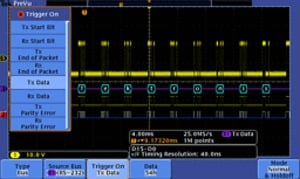
Capture ‒ Triggering on a specific transmit data packet going across an RS-232 bus. A complete set of triggers, including triggers for specific serial packet content, ensures you quickly capture your event of interest.
Search
Finding your event of interest in a long waveform record can be time consuming without the right search tools. With today’s record lengths pushing beyond a million data points, locating your event can mean scrolling through thousands of screens of signal activity.
The innovative Wave Inspector® controls give you the industry’s most comprehensive search and waveform navigation capability. These controls speed panning and zooming through your record. With a unique force-feedback system, you can move from one end of your record to the other in just seconds. User marks allow you to mark any location that you may want to reference later for further investigation. Or, automatically search your record for criteria you define. Wave Inspector will instantly search your entire record, including analog, digital, and serial bus data. Along the way it will automatically mark every occurrence of your defined event so you can quickly move between events.

Search ‒ I2C decode showing results from a Wave Inspector search for Address value 50. Wave Inspector controls provide unprecedented efficiency in viewing and navigating waveform data.
Analyze
Verifying that your prototype’s performance matches simulations and meets the project’s design goals requires analyzing its behavior. Tasks can range from simple checks of rise times and pulse widths to sophisticated power loss analysis and investigation of noise sources.
The oscilloscope offers a comprehensive set of integrated analysis tools including waveform- and screen-based cursors, automated measurements, advanced waveform math including arbitrary equation editing, FFT analysis, and trend plots for visually determining how a measurement is changing over time. Specialized application support for serial bus analysis, power supply design, and video design and development is also available.

Analyze ‒ FFT analysis of a pulsed signal. A comprehensive set of integrated analysis tools speeds verification of your design's performance.
Wave Inspector® navigation and search
With long record lengths, a single acquisition can include thousands of screens of waveform data. Wave Inspector®, the industry’s best tool for navigation and search, enables you to find events of interest in seconds.
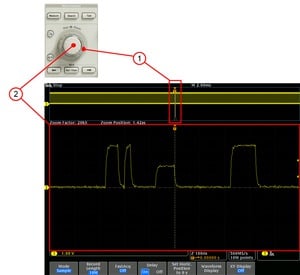
Wave Inspector controls provide unprecedented efficiency in viewing, navigating, and analyzing waveform data. Zip through your long record by turning the outer pan control (1). Get details from the beginning to end in seconds. See something of interest and want to see more details? Just turn the inner zoom control (2).
Zoom and pan
A dedicated, two-tier front-panel control provides intuitive control of both zooming and panning. The inner control adjusts the zoom factor (or zoom scale); turning it clockwise activates zoom and goes to progressively higher zoom factors, while turning it counterclockwise results in lower zoom factors and eventually turning zoom off. No longer do you need to navigate through multiple menus to adjust your zoom view. The outer control pans the zoom box across the waveform to quickly get to the portion of waveform you are interested in. The outer control also utilizes force-feedback to determine how fast to pan on the waveform. The farther you turn the outer control, the faster the zoom box moves. Pan direction is changed by simply turning the control the other way.
Play/Pause
A dedicated Play/Pause front-panel button scrolls the waveform across the display automatically while you look for anomalies or an event of interest. Playback speed and direction are controlled using the intuitive pan control. Once again, turning the control further makes the waveform scroll faster and changing direction is as simple as turning the control the other way.
User marks
Press the Set Mark front-panel button to place one or more marks on the waveform. Navigating between marks is as simple as pressing the Previous (←) and Next (→) buttons on the front panel.
Search marks
The Search button allows you to automatically search through your long acquisition looking for user-defined events. All occurrences of the event are highlighted with search marks and are easily navigated to, using the front-panel Previous (←) and Next (→) buttons. Search types include edge, pulse width/glitch, timeout, runt, logic, setup and hold, rise/fall time, parallel bus, and I2C, SPI, CAN, LIN, FlexRay, RS-232/422/485/UART, MIL-STD-1553, and I2S/LJ/RJ/TDM packet content.

Search step 1: You define what you would like to find.
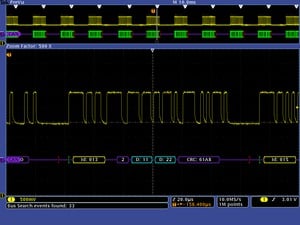
Search step 2: Wave Inspector automatically searches through the record and marks each event with a hollow white triangle. You can then use the Previous and Next buttons to jump from one event to the next.
Digital phosphor technology with FastAcq®
Digital phosphor technology with FastAcq provides you with fast insight into the real operation of your device. Its fast waveform capture rate – greater than 340,000 wfms/s – gives you a high probability of quickly seeing the infrequent problems common in digital systems: runt pulses, glitches, timing issues, and more.
To further enhance the visibility of rarely occurring events, intensity grading is used to indicate how often rare transients are occurring relative to normal signal characteristics. There are four waveform palettes available in FastAcq acquisition mode.
- The Temperature palette uses color-grading to indicate frequency of occurrence with hot colors like red/yellow indicating frequently occurring events and colder colors like blue/green indicating rarely occurring events.
- The Spectral palette uses color-grading to indicate frequency of occurrence with colder colors like blue indicating frequently occurring events and hot colors like red indicating rarely occurring events.
- The Normal palette uses the default channel color (like yellow for channel one) along with gray-scale to indicate frequency of occurrence where frequently occurring events are bright.
- The Inverted palette uses the default channel color along with gray- scale to indicate frequency of occurrence where rarely occurring events are bright.
These color palettes quickly highlight the events that over time occur more often or, in the case of infrequent anomalies, occur less often.
Infinite or variable persistence choices determine how long waveforms stay on the display, helping you to determine how often an anomaly is occurring.
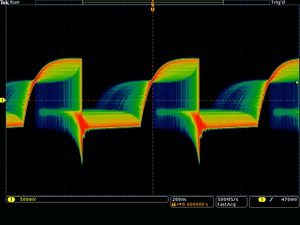
Digital phosphor technology enables a greater than 340,000 wfm/s waveform capture rate and real-time intensity grading.
Mixed signal design and analysis
The MDO4000B provides 16 digital channels which are tightly integrated into the oscilloscope's user interface. This simplifies operation and makes it possible to solve mixed-signal issues easily.

The MDO4000B Series provides 16 integrated digital channels enabling you to view and analyze time-correlated analog and digital signals.
Color-coded digital waveform display
This oscilloscope has redefined the way you view digital waveforms. One common problem shared by both logic analyzers and mixed-signal oscilloscopes is determining if data is a one or a zero when zoomed in far enough that the digital trace stays flat all the way across the display. Color-coded digital traces display ones in green and zeros in blue.
The multiple transition detection hardware shows you a white edge on the display when the system detects multiple transitions. White edges indicate that more information is available by zooming in or acquiring at faster sampling rates. In most cases zooming in will reveal the pulse that was not viewable with the previous settings. If the white edge is still present after zooming in as far as possible, this indicates that increasing the sample rate on the next acquisition will reveal higher frequency information than the previous settings could acquire.
You can group digital waveforms and enter waveform labels by using a USB keyboard. By simply placing digital waveforms next to each other, they form a group.
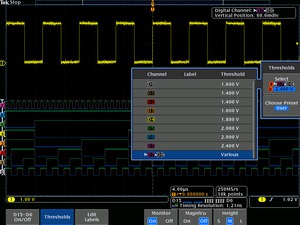
With color-coded digital waveform display, groups are created by simply placing digital channels together on the screen, allowing digital channels to be moved as a group. You can set threshold values for each channel, enabling support for up to 16 different logic families.
Once a group is formed, you can position all the channels contained in that group collectively. This greatly reduces the normal setup time associated with positioning channels individually.
MagniVu™ high-speed acquisition
The main digital acquisition mode on the MSO3000 Series will capture up to 5 Mpoints at 500 MS/s (2 ns resolution). In addition to the main record, the MSO3000 provides an ultra high-resolution record called MagniVu which acquires 10,000 points at up to 8.25 GS/s (121.2 ps resolution). Both main and MagniVu waveforms are acquired on every trigger and can be switched between in the display at any time, running or stopped. MagniVu provides significantly finer timing resolution than comparable MSOs on the market, instilling confidence when making critical timing measurements on digital waveforms.
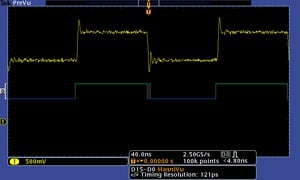
The MagniVu high-resolution record provides 121.2 ps timing resolution, enabling you to take critical timing measurements on your digital waveforms.
P6316 MSO probe
This unique probe design offers two eight-channel pods, simplifying the process of connecting to the device-under-test. When connecting to square pins, the P6316 can connect directly to 8×2 square pin headers spaced on tenth-inch centers. When more attachment flexibility is required, you can use the included flying lead sets and grabbers to clip onto surface mount devices or test points. The P6316 offers outstanding electrical characteristics applying only 8 pF of capacitive loading with 101 kΩ input impedance.
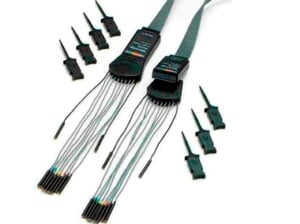
The P6316 MSO probe offers two eight-channel pods to simplify connecting to your device.
Serial triggering and analysis (optional)
On a serial bus, a single signal often includes address, control, data, and clock information. This can make isolating events of interest difficult. Automatic trigger, decode, and search on bus events and conditions gives you a robust set of tools for debugging serial buses. The optional serial protocol triggering and analysis functionality is offered free for a 30-day trial period. This free trial period starts automatically when the instrument is powered on for the first time.
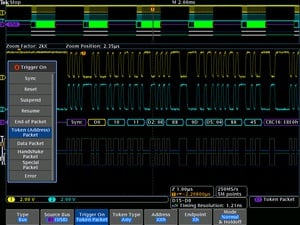
Triggering on a specific data packet going across an I2C bus. The yellow waveform is clock and the blue waveform is the data. A bus waveform provides decoded packet content including Start, Address, Read/Write, Data, and Stop.
Serial triggering
Trigger on packet content such as start of packet, specific addresses, specific data content, unique identifiers, etc. on popular serial interfaces such as I2C, SPI, MIL-STD-1553, CAN, LIN, FlexRay, RS-232/422/485/UART, and I2S/LJ/RJ/TDM.
Bus display
Provides a higher-level, combined view of the individual signals (clock, data, chip enable, etc.) that make up your bus, making it easy to identify where packets begin and end and identifying sub-packet components such as address, data, identifier, CRC, etc.
Bus decoding
Tired of having to visually inspect the waveform to count clocks, determine if each bit is a 1 or a 0, combine bits into bytes, and determine the hex value? Let the oscilloscope do it for you! Once you’ve set up a bus, the MSO/DPO3000 Series will decode each packet on the bus, and display the value in hex, binary, decimal (LIN, FlexRay, and MIL-STD-1553 only), signed decimal (I2S/LJ/RJ/TDM only), or ASCII (MIL-STD-1553 and RS-232/422/485/UART only) in the bus waveform.
Event table
In addition to seeing decoded packet data on the bus waveform itself, you can view all captured packets in a tabular view much like you would see in a software listing. Packets are time stamped and listed consecutively with columns for each component (Address, Data, etc.). You can save the event table data in .csv format.
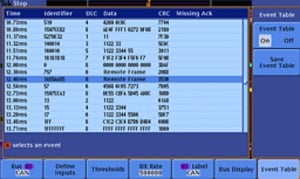
Event table showing decoded identifier, DLC, DATA, and CRC for every CAN packet in a long acquisition.
| Technology | Trigger, Decode, Search | Order product | |
|---|---|---|---|
| Embedded | I2C | Yes | DPO4EMBD |
| SPI | Yes | DPO4EMBD | |
| Computer | RS232/422/485, UART | Yes | DPO4COMP |
| USB | USB LS, FS, HS | Yes | DPO4USB |
| Ethernet | 10Base-T, 100Base-TX | Yes | DPO4ENET |
| Automotive | CAN | Yes | DPO4AUTO or DPO4AUTOMAX |
| LIN | Yes | DPO4AUTO or DPO4AUTOMAX | |
| FlexRay | Yes | DPO4AUTOMAX | |
| Military and Aerospace | MIL-STD-1553 | Yes | DPO4AERO |
| Audio | I2S | Yes | DPO4AUDIO |
| LJ, RJ | Yes | DPO4AUDIO | |
| TDM | Yes | DPO4AUDIO | |
Search (serial triggering)
Serial triggering is very useful for isolating the event of interest, but once you’ve captured it and need to analyze the surrounding data, what do you do? In the past, users had to manually scroll through the waveform counting and converting bits and looking for what caused the event. You can have the oscilloscope automatically search through the acquired data for user-defined criteria including serial packet content. Each occurrence is highlighted by a search mark. Rapid navigation between marks is as simple as pressing the Previous (←) and Next (→) buttons on the front panel.
| Technology | Trigger | Bus decode | Event table | Search | Order product | |
|---|---|---|---|---|---|---|
| Embedded | I2C | ■ | ■ | ■ | ■ | DPO3EMBD |
| SPI | ■ | ■ | ■ | ■ | DPO3EMBD | |
| Computer | RS232/422/485, UART | ■ | ■ | ■ | ■ | DPO3COMP |
| Automotive | CAN | ■ | ■ | ■ | ■ | DPO3AUTO |
| LIN | ■ | ■ | ■ | ■ | DPO3AUTO | |
| FlexRay | ■ | ■ | ■ | ■ | DPO3FLEX | |
| Military and aerospace | MIL-STD-1553 | ■ | ■ | ■ | ■ | DPO3AERO |
| Audio | I2S | ■ | ■ | ■ | ■ | DPO3AUDIO |
| LJ, RJ | ■ | ■ | ■ | ■ | DPO3AUDIO | |
| TDM | ■ | ■ | ■ | ■ | DPO3AUDIO | |
Power analysis (optional)
Ever increasing consumer demand for longer battery-life devices and for green solutions that consume less power require power-supply designers to characterize and minimize switching losses to improve efficiency. In addition, the supply’s power levels, output purity, and harmonic feedback into the power line must be characterized to comply with national and regional power quality standards. Historically, making these and many other power measurements on an oscilloscope has been a long, manual, and tedious process. The optional power analysis tools greatly simplify these tasks, enabling quick and accurate analysis of power quality, switching loss, harmonics, safe operating area (SOA), modulation, ripple, and slew rate (di/dt, dv/dt). Completely integrated into the oscilloscope, the power analysis tools provide automated, repeatable power measurements with a touch of a button; no external PC or complex software setup is required. The optional power analysis functionality is offered free for a 30-day trial period. This free trial period starts automatically when the instrument is powered on for the first time.
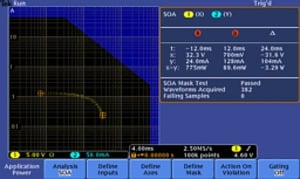
Safe operating area measurement. Automated power measurements enable quick and accurate analysis of common power parameters.
Video design and development
Many video engineers have remained loyal to analog oscilloscopes, believing the intensity gradations on an analog display are the only way to see certain video waveform details. The fast waveform capture rate, coupled with its intensity-graded view of the signal, provides the same information-rich display as an analog oscilloscope, but with much more detail and all the benefits of digital scopes.
Standard features such as IRE and mV graticules, holdoff by fields, video polarity, and an Autoset smart enough to detect video signals, make these the easiest to use oscilloscopes on the market for video applications. And with high bandwidth, four analog inputs, and a built-in 75 Ω input termination, the oscilloscope provides ample performance for analog and digital video use.
The video functionality is further extended with the optional video application module, which provides the industry's most complete suite of HDTV and custom (nonstandard) video triggers.
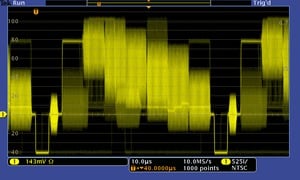
Viewing an NTSC video signal. Notice the intensity-graded view provided by the MDO's ability to represent time, amplitude, and distribution over time.
Designed to make your work easier
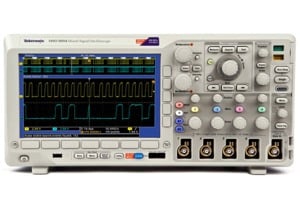
The MSO/DPO3000 is designed to make your work easier. The large, high-resolution display shows intricate signal details. Dedicated front-panel controls simplify operation. A USB host port on the front panel allows you to easily transfer screen shots, instrument settings, and waveform data to a USB mass storage device.
Large high-resolution display
The MSO/DPO3000 Series features a 9 inch (229 mm) wide-screen, high-resolution (800 × 480 WVGA) display for seeing intricate signal details.
Dedicated front-panel controls
Per-channel vertical controls provide simple and intuitive operation. No longer do you need to share one set of vertical controls across all four channels.
Connectivity
A USB host port on the front panel enables easy transfer of screen shots, instrument settings, and waveform data to a USB mass storage device. The rear panel contains a second USB host port and a USB device port for controlling the oscilloscope remotely from a PC or for connecting a USB keyboard. The USB device port can also be used to print directly to a PictBridge®-compatible printer. An integrated 10/100 Ethernet port enables easy connection to networks and a Video Out port allows the oscilloscope display to be exported to an external monitor or projector.
Compact form factor
With the compact, portable form factor, you can easily move the oscilloscope between labs. And with a depth of just 5.8 inches (147 mm), it saves you valuable space on your test bench.
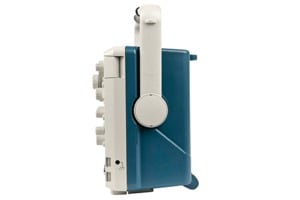
The MSO/DPO3000 Series compact form factor frees up valuable space on your bench or desktop.
TekVPI® probe interface
The TekVPI probe interface sets the standard for ease of use in probing. In addition to the secure, reliable connection that the interface provides, TekVPI probes feature status indicators and controls, as well as a probe menu button right on the comp box itself. This button brings up a probe menu on the oscilloscope display with all relevant settings and controls for the probe. The TekVPI interface enables direct attachment of current probes without requiring a separate power supply. TekVPI probes can be controlled remotely through USB, GPIB, or LAN, enabling more versatile solutions in ATE environments. The instrument provides up to 50 W of power to the front panel TekVPI connectors from the internal power supply, giving you the confidence that it can meet any demanding probing requirements you have.
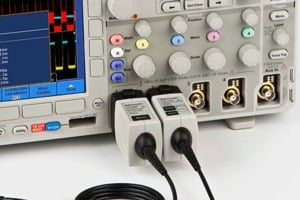
TekVPI probe interface simplifies connecting your probes to the oscilloscope.
Remote connectivity and instrument control
Exporting data and measurements is as simple as connecting a USB cable from the oscilloscope to your PC. Key software applications – OpenChoice® Desktop, and Microsoft Excel and Word toolbars – are included standard with each oscilloscope to enable fast and easy direct communication with your Windows PC.
The included OpenChoice Desktop enables fast and easy communication between the oscilloscope and your PC through USB or LAN for transferring settings, waveforms, and screen images.

NI LabVIEW SignalExpress™ Tektronix Edition is a fully interactive measurement and analysis software package developed jointly with National Instruments and optimized for the MSO/DPO Series.
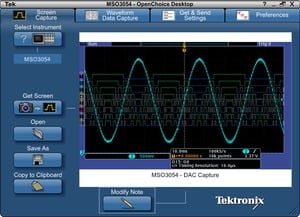
OpenChoice® Desktop software enables seamless connection between the oscilloscope and your PC.
The embedded e*Scope® capability enables fast control of the oscilloscope over a network connection through a standard web browser. Simply enter the IP address or network name of the oscilloscope and a web page will be served to the browser. Transfer and save settings, waveforms, measurements, and screen images or make live control changes to settings on the oscilloscope directly from the web browser.
Specifications
All specifications are guaranteed unless noted otherwise. All specifications apply to all models unless noted otherwise.
Model overview
| MSO3012 and DPO3012 | MSO3014 and DPO3014 | MSO3032 and DPO3032 | MSO3034 and DPO3034 | DPO3052 | MSO3054 and DPO3054 | |
|---|---|---|---|---|---|---|
| Analog channels | 2 | 4 | 2 | 4 | 2 | 4 |
| Analog bandwidth (-3dB) | 100 MHz | 100 MHz | 300 MHz | 300 MHz | 500 MHz | 500 MHz |
| Calculated rise time at 5 mv/div, typical | 3.5 ns | 3.5 ns | 1.17 ns | 1.17 ns | 700 ps | 700 ps |
| Sample rate (analog channels) | 2.5 GS/s | 2.5 GS/s | 2.5 GS/s | 2.5 GS/s | 2.5 GS/s | 2.5 GS/s |
| Record length | 5 M points | 5 M points | 5 M points | 5 M points | 5 M points | 5 M points |
| Digital channels | MSO models add 16 digital channels to the corresponding DPO model | |||||
Vertical system analog channels
- Hardware bandwidth limits
-
- ≥300 MHz models
- 20 MHz and 150 MHz
- 100 MHz models
- 20 MHz
- Input impedance
- 1 MΩ ±1%, 75 Ω ± 1%, 50 Ω ±1%
- Input sensitivity range
-
- 1 MΩ
- 1 mV/div to 10 V/div
- 75 Ω, 50 Ω
- 1 mV/div to 1 V/div
- Vertical resolution
- 8 bits (11 bits with Hi Res)
- Maximum input voltage
-
- 1 MΩ
- 300 VRMS with peaks ≤ ±450 V
- 75 Ω, 50 Ω
- 5 VRMS with peaks ≤ ±20 V
- DC gain accuracy
-
±1.5% for 5 mV/div and above
±2.0% for 2 mV/div
±2.5% for 1 mV/div
- Channel-to-channel isolation
- Any two channels at equal vertical scale
Vertical system digital channels
- Thresholds
- Threshold per set of 8 channels
- Threshold selections
- TTL, CMOS, ECL, PECL, User-defined
- User-defined threshold range
- –15 V to +25 V
- Maximum input voltage
- –20 V to +30 V
- Threshold accuracy
- ±[100 mV + 3% of threshold setting]
- Maximum input dynamic range
- 50 Vp-p (threshold setting dependent)
- Minimum voltage swing
- 500 mVp-p
- Input resistance
- 101 kΩ
- Probe loading
- 8 pF
- Vertical resolution
- 1 bit
Horizontal system analog channels
- Maximum duration of time captured at highest sample rate (all channels)
- 2 ms
- Seconds/division range
- 1 ns/div to 1000 s/div
- Time-base delay time range
- -10 divisions to 5000 s
- Channel-to-channel deskew range
- ±100 ns
- Time base accuracy
- ±10 ppm over any ≥1 ms interval
Horizontal system digital channels
- Seconds/division range
- 1 ns/div to 1000 s/div
- Maximum record length (main, all channels)
- 5 M points
- Maximum sample rate (MagniVu, all channels)
- 8.25 GS/s (121.2 ps resolution)
- Maximum record length (MagniVu, all channels)
- 10 k points centered on the trigger
- Minimum detectible pulse width
- 2.0 ns
- Channel-to-channel skew
- 500 ps, typical, digital channel to digital channel only
Trigger system
- Trigger modes
- Auto, Normal, and Single
- Trigger coupling
- DC, AC, HF reject (attenuates >50 kHz), LF reject (attenuates <50 kHz), noise reject (reduces sensitivity)
- Trigger holdoff range
- 20 ns to 8 s
- Trigger sensitivity, typical
-
Edge type, DC coupled
Trigger Source Sensitivity Any input channel 0.50 div from DC to 50 MHz, increasing to 1 div at oscilloscope bandwidth Aux input (external trigger) 200 mV from DC to 50 MHz, increasing to 500 mV at 250 MHz Line Fixed
- Trigger level ranges
-
- Any input channel
- ±8 divisions from center of screen, ±8 divisions from 0 V when vertical LF reject trigger coupling is selected
- Aux Input (external trigger)
- ±8 V
- Line
- The line trigger level is fixed at about 50% of the line voltage.
- Trigger types
-
- Edge
- Positive, negative, or either slope on any channel or front-panel auxiliary input. Coupling includes DC, AC, HF reject, LF reject, and noise reject.
- Sequence (B-trigger)
- Trigger Delay by Time: 8 ns to 8 s. Or Trigger Delay by Events: 1 to 9,999,999 events.
- Pulse Width
- Trigger on width of positive or negative pulses that are >, <, =, ≠, or inside/outside a specified period of time.
- Timeout
- Trigger on an event which remains high, low, or either, for a specified time period (4 ns to 8 s).
- Runt
- Trigger on a pulse that crosses one threshold but fails to cross a second threshold before crossing the first again.
- Logic
- Trigger when any logical pattern of channels goes false or stays true for specified period of time. Any input can be used as a clock to look for the pattern on a clock edge. Pattern (AND, OR, NAND, NOR) specified for all input channels defined as High, Low, or Don’t Care.
- Setup and Hold
- Trigger on violations of both setup time and hold time between clock and data present on any of the analog and digital input channels.
- Rise/Fall Time
- Trigger on pulse edge rates that are faster or slower than specified. Slope may be positive, negative, or either.
- Video
- Trigger on all lines, odd, even, or all fields on NTSC, PAL, and SECAM video signals.
- Extended Video (optional)
- Trigger on 480p/60, 576p/50, 720p/30, 720p/50, 720p/60, 875i/60, 1080i/50, 1080i/60, 1080p/24, 1080p/24sF, 1080p/25, 1080p/30, 1080p/50, 1080p/60, and custom bi-level and tri-level sync video standards.
- I2C (optional)
- Trigger on Start, Repeated Start, Stop, Missing ACK, Address (7 or 10 bit), Data, or Address and Data on I2C buses up to 10 Mb/s.
- SPI (optional)
- Trigger on SS, MOSI, MISO, or MOSI and MISO on SPI buses up to 10.0 Mb/s.
- RS-232/422/485/UART (optional)
- Trigger on Tx Start Bit, Rx Start Bit, Tx End of Packet, Rx End of Packet, Tx Data, Rx Data, Tx Parity Error, and Rx Parity Error up to 10 Mb/s.
- CAN (optional)
- Trigger on Start of Frame, Frame Type (data, remote, error, overload), Identifier (standard or extended), Data, Identifier and Data, End of Frame, Missing ACK, or Bit Stuffing Error on CAN signals up to 1 Mb/s. Data can be further specified to trigger on ≤, <, =, >, ≥, or ≠ a specific data value. User-adjustable sample point is set to 50% by default.
- LIN (optional)
- Trigger on Sync, Identifier, Data, Identifier and Data, Wakeup Frame, Sleep Frame, Errors such as Sync, Parity, or Checksum Errors up to 100 kb/s (by LIN definition, 20 kb/s).
- FlexRay (optional)
- Trigger on Start of Frame, Type of Frame (Normal, Payload, Null, Sync, Startup), Identifier, Cycle Count, Complete Header Field, Data, Identifier and Data, End of Frame or Errors such as Header CRC, Trailer CRC, Null Frame, Sync Frame, or Startup Frame Errors up to 100 Mb/s.
- MIL-STD-1553 (optional)
- Trigger on Sync, Word Type 1 (Command, Status, Data), Command Word (set RT Address, T/R, Sub-address/Mode, Data Word Count/Mode Code, and Parity individually), Status Word (set RT Address, Message Error, Instrumentation, Service Request Bit, Broadcast Command Received, Busy, Subsystem Flag, Dynamic Bus Control Acceptance (DBCA), Terminal Flag, and Parity individually), Data Word (user-specified 16-bit data value), Error (Sync, Parity, Manchester, Non-contiguous data), Idle Time (minimum time selectable from 2 µs to 100 µs; maximum time selectable from 2 µs to 100 µs; trigger on < minimum, > maximum, inside range, outside range). RT Address can be further specified to trigger on =, ≠, <, >, ≤, ≥ a particular value, or inside or outside of a range.
- I2S/LJ/RJ/TDM (optional)
- Trigger on Word Select, Frame Sync, or Data. Data can be further specified to trigger on ≤, <, =, >, ≥, ≠ a specific data value, or inside or outside of a range.
- Parallel (available on MSO models only)
- Trigger on a parallel bus data value. Parallel bus can be from 1 to 16 bits (from the digital channels) plus 2 or 4 bits (from the analog channels) in size. Binary and Hex radices are supported.
1 Trigger selection of Command Word will trigger on Command and ambiguous Command/Status words. Trigger selection of Status Word will trigger on Status and ambiguous Command/Status words.
Acquisition system
- Acquisition Modes
-
- Sample
- Acquire sampled values.
- Peak Detect
- Captures glitches as narrow as 2 ns at all sweep speeds.
- Averaging
- From 2 to 512 waveforms included in average.
- Envelope
- Min-max envelope reflecting Peak Detect data over multiple acquisitions.
- Hi Res
- Real-time boxcar averaging reduces random noise and increases vertical resolution.
- Roll
- Scrolls waveforms right to left across the screen at sweep speeds slower than or equal to 40 ms/div.
- FastAcq®
- FastAcq optimizes the instrument for analysis of dynamic signals and capture of infrequent events, capturing >340,000 wfms/s on 1 GHz models and >270,000 wfms/s on 100 MHz - 500 MHz models.
Waveform measurements
- Cursors
- Waveform and Screen.
- Automatic measurements
- 29, of which up to four can be displayed on-screen at any one time. Measurements include: Period, Frequency, Delay, Rise Time, Fall Time, Positive Duty Cycle, Negative Duty Cycle, Positive Pulse Width, Negative Pulse Width, Burst Width, Phase, Positive Overshoot, Negative Overshoot, Peak to Peak, Amplitude, High, Low, Max, Min, Mean, Cycle Mean, RMS, Cycle RMS, Positive Pulse Count, Negative Pulse Count, Rising Edge Count, Falling Edge Count, Area and Cycle Area.
- Measurement statistics
- Mean, Min, Max, Standard Deviation.
- Reference levels
- User-definable reference levels for automatic measurements can be specified in either percent or units.
- Gating
- Isolate the specific occurrence within an acquisition to take measurements on, using either the screen, or waveform cursors.
Power measurements (optional)
- Power Quality Measurements
- VRMS, VCrest Factor, Frequency, IRMS, ICrest Factor, True Power, Apparent Power, Reactive Power, Power Factor, Phase Angle.
- Switching loss measurements
-
- Power loss
- Ton, Toff, Conduction, Total.
- Energy loss
- Ton, Toff, Conduction, Total.
- Harmonics
- THD-F, THD-R, RMS measurements. Graphical and table displays of harmonics. Test to IEC61000-3-2 Class A and MIL-STD-1399, Section 300A.
- Ripple measurements
- VRipple and IRipple.
- Modulation Analysis
- Graphical display of +Pulse Width, –Pulse Width, Period, Frequency, +Duty Cycle, and –Duty Cycle modulation types.
- Safe operating area
- Graphical display and mask testing of switching device safe operating area measurements.
- dV/dt and dI/dt measurements
- Cursor measurements of slew rate.
Waveform math
- Arithmetic
- Add, subtract, multiply, and divide waveforms.
- Math functions
- Integrate, Differentiate, FFT.
- FFT
- Spectral magnitude. Set FFT Vertical Scale to Linear RMS or dBV RMS, and FFT Window to Rectangular, Hamming, Hanning, or Blackman-Harris.
- Advanced math
- Define extensive algebraic expressions including waveforms, reference waveforms, math functions (FFT, Intg, Diff, Log, Exp, Sqrt, Sine, Cosine, Tangent), scalars, up to two user-adjustable variables and results of parametric measurements (Period, Freq, Delay, Rise, Fall, PosWidth, NegWidth, BurstWidth, Phase, PosDutyCycle, NegDutyCycle, PosOverShoot, NegOverShoot, PeakPeak, Amplitude, RMS, CycleRMS, High, Low, Max, Min, Mean, CycleMean, Area, CycleArea, and trend plots), e.g.,(Intg(Ch1 - Mean(Ch1)) × 1.414 × VAR1).
Software
- NI LabVIEW SignalExpress™ Tektronix Edition
-
A fully interactive measurement software environment optimized for your Tektronix oscilloscope, enables you to instantly acquire, generate, analyze, compare, import, and save measurement data and signals using an intuitive drag-and-drop user interface that does not require any programming.
Standard support for acquiring, controlling, viewing, and exporting your live analog-channel signal data is permanently available through the software. The full version (SIGEXPTE) adds additional signal processing, advanced analysis, mixed signal, sweeping, limit testing, and user-defined step capabilities and is available for a 30-day trial period standard with each instrument.
- OpenChoice® Desktop
- Enables fast and easy communication between a Windows PC and your oscilloscope using USB or LAN. Transfer and save settings, waveforms, measurements, and screen images. Included Word and Excel toolbars automate the transfer of acquisition data and screen images from the oscilloscope into Word and Excel for quick reporting or further analysis.
- IVI driver
- Provides a standard instrument programming interface for common applications such as LabVIEW, LabWindows/CVI, Microsoft .NET, and MATLAB.
- e*Scope® Web-based remote control
- Enables control of the oscilloscope over a network connection through a standard web browser. Simply enter the IP address or network name of the oscilloscope and a web page will be served to the browser. Transfer and save settings, waveforms, measurements, and screen images or make live control changes to settings on the oscilloscope directly from the web browser.
Display system
- Display type
- 9 inch (228.6 mm) wide format liquid crystal TFT color display.
- Display resolution
- 800 horizontal × 480 vertical pixels (WVGA).
- Waveform styles
- Vectors, Dots, Variable Persistence, Infinite Persistence.
- Graticules
- Full, Grid, Cross Hair, Frame, IRE and mV.
- Format
- YT and XY.
- Maximum waveform capture rate
-
>340,000 wfms/s in FastAcq acquisition mode on 1 GHz models
>270,000 wfms/s in FastAcq acquisition mode on 100 MHz - 500 MHz models
>50,000 wfms/s in DPO acquisition mode on all models.
Input/output ports
- USB 2.0 high-speed host port
- Supports USB mass storage devices, printers, and keyboards. One port available on rear panel and one on front panel.
- USB 2.0 high-speed device port
- Rear-panel connector allows for communication/control of oscilloscope through USBTMC or GPIB with a TEK-USB-488, and direct printing to all PictBridge®-compatible printers.
- LAN port (Ethernet)
- RJ-45 connector, supports 10/100BASE-T.
- GPIB interface
- Available as an optional accessory that connects to the USB Device and USB Host port with the TEK-USB-488 GPIB to USB Adapter.
- Video out port
- DB-15 female connector, connect to show the oscilloscope display on an external monitor or projector. SVGA resolution.
- Auxiliary input
- Front-panel BNC connector. Input Impedance 1 MΩ. Max input 300 VRMS CAT II with peaks ≤ ±425 V.
- Probe compensator output voltage and frequency
- Front-panel pins
- Amplitude
- 0 to 2.5 V
- Frequency
- 1 kHz
- Trigger out
- Rear-panel BNC connector, provides a negative-polarity pulse when the oscilloscope triggers.
- Kensington-style lock
- Rear-panel security slot connects to standard Kensington-style lock.
Power source
- Power source voltage
- 85 to 265 V ±10%
- Power source frequency
- 45 to 440 Hz (85 to 265 V)
- Power consumption
- 120 W maximum
- Optional TekVPI® external power supply 1
-
- Output voltage
- 12 V
- Output current
- 5 A
- Power consumption
- 50 W
1 Required when total oscilloscope probe power usage exceeds 20 W.
Physical characteristics
- Dimensions
-
mm in. Height 203.2 8 Width 416.6 16.4 Depth 147.3 5.8
- Weight
-
kg lb. Net 4.17 9.2 Shipping 8.62 19
- Rackmount configuration
- 5U
- Cooling clearance
- 2 in. (51 mm) required on left side and rear of instrument
EMC, environment, and safety
- Temperature
-
- Operating
- 0 ºC to +50 ºC (+32 ºF to 122 ºF)
- Nonoperating
- -40 ºC to +71 ºC (-40 ºF to 160 ºF)
- Humidity
-
- Operating
- High: 30 ºC to 50 ºC, 5% to 45% relative humidity
- Nonoperating
- High: 30 ºC to 50 ºC, 5%to 45% relative humidity
- Altitude
-
- Operating
- 3,000 meters (9,843 feet)
- Nonoperating
- 12,000 meters (39,370 feet)
- Random vibration
-
- Operating
- 0.31 GRMS from 5 to 500 Hz, 10 minutes each axis, 3 axes, 30 minutes total
- Nonoperating
- 2.46 GRMS from 5 to 500 Hz, 10 minutes each axis, 3 axes, 30 minutes total
- Regulatory
-
- Electromagnetic compatibility
- EC Council Directive 2004/108/EC
- Safety
- UL61010-1:2004, CAN/CSA-C22.2 No. 61010.1: 2004, Low Voltage Directive 2006/95/EC and EN61010-1:2001, IEC 61010-1:2001, ANSI 61010-1-2004, ISA 82.02.01
Ordering information
DPO3000 and MSO3000 models
- DPO3012
- 100 MHz, 2.5 GS/s, 5 M record length, 2-channel digital phosphor oscilloscope
- DPO3014
- 100 MHz, 2.5 GS/s, 5 M record length, 4-channel digital phosphor oscilloscope
- DPO3032
- 300 MHz, 2.5 GS/s, 5 M record length, 2-channel digital phosphor oscilloscope
- DPO3034
- 300 MHz, 2.5 GS/s, 5 M record length, 4-channel digital phosphor oscilloscope
- DPO3052
- 500 MHz, 2.5 GS/s, 5 M record length, 2-channel digital phosphor oscilloscope
- DPO3054
- 500 MHz, 2.5 GS/s, 5 M record length, 4-channel digital phosphor oscilloscope
- MSO3012
- 100 MHz, 2.5 GS/s, 5 M record length, 2+16 channel mixed-signal oscilloscope
- MSO3014
- 100 MHz, 2.5 GS/s, 5 M record length, 4+16 channel mixed-signal oscilloscope
- MSO3032
- 300 MHz, 2.5 GS/s, 5 M record length, 2+16 channel mixed-signal oscilloscope
- MSO3034
- 300 MHz, 2.5 GS/s, 5 M record length, 4+16 channel mixed-signal oscilloscope
- MSO3054
- 500 MHz, 2.5 GS/s, 5 M record length, 4+16 channel mixed-signal oscilloscope
Standard accessories
Probes
- P6139A
- 500 MHz, 10x passive probe (one per analog channel)
- P6316 (MSO models only)
- 16-channel logic probe and accessory kit (one per instrument)
Accessories
Please specify power plug and manual language version when ordering.
- 200-5052-xx
- Front cover
- 063-4104-xx
- Documentation CD
- 016-2008-xx
- Accessory pouch
- —
- User manual
- —
- Power cord
- —
- OpenChoice® Desktop software
- —
- NI LabVIEW SignalExpress™ Tektronix Edition LE software
- —
- Calibration certificate documenting traceability to National Metrology Institute(s) and ISO9001 quality system registration
Warranty
Three-year warranty covering all parts and labor on the MSO4000B or DPO4000B instrument. One-year warranty covering parts and labor on included probes.
Application modules
Application modules have licenses which can be transferred between an application module and an oscilloscope. The license may be contained in the module; allowing the module to be moved from one instrument to another. Or, the license can be contained in the oscilloscope; allowing the module to be removed and stored for safekeeping. Transferring the license to an oscilloscope and removing the module permits the use of more than 4 applications simultaneously.
- DPO3AERO
-
Aerospace Serial Triggering and Analysis Module. Enables triggering on packet-level information on MIL-STD-1553 buses as well as analytical tools such as digital views of the signal, bus views, packet decoding, search tools, and packet decode tables with time-stamp information.
Signal Inputs - Any Ch1 - Ch4, Math, Ref1 - Ref4
Recommended Probing - Differential or single ended (only one single-ended signal required)
- DPO3AUDIO
-
Audio Serial Triggering and Analysis Module. Enables triggering on packet-level information on I2S, Left Justified, Right Justified, TDM, and custom audio buses, as well as analytical tools such as digital views of the signal, bus views, packet decoding, search tools, and packet decode tables with time stamp information.
Signal Inputs - Any Ch1 - Ch4 (and any D0 - D15 on MSO models)
Recommended Probing - Single ended
- DPO3AUTO
-
Automotive Serial Triggering and Analysis Module. Enables triggering on packet-level information on CAN bus and LIN bus as well as analytical tools such as digital views of the signal, bus views, packet decoding, search tools, and packet decode tables with time stamp information.
Signal Inputs - LIN: Any Ch1 - Ch4 (and any D0 - D15 on MSO models); CAN: Any Ch1 - Ch4 (and any D0 - D15 on MSO models; single-ended probing only)
Recommended Probing - LIN: Single ended; CAN: Single ended or differential
- DPO3COMP
-
Computer Serial Triggering and Analysis Module. Enables triggering on packet-level information on RS-232/422/485/UART buses as well as analytical tools such as digital views of the signal, bus views, packet decoding, search tools, and packet decode tables with time stamp information.
Signal Inputs - Any Ch1 - Ch4 (and any D0 - D15 on MSO models; single-ended probing only)
Recommended Probing - RS-232/UART: Single ended; RS-422/485: Differential
- DPO3EMBD
-
Embedded Serial Triggering and Analysis Module. Enables triggering on packet-level information on I2C and SPI buses as well as analytical tools such as digital views of the signal, bus views, packet decoding, search tools, and packet decode tables with time stamp information. Only two-wire SPI support available on DPO3012, DPO3032, and DPO3052 models.
Signal Inputs - I2C: Any Ch1 - Ch4 (and any D0 - D15 on MSO models); SPI: Any Ch1 - Ch4 (and any D0 - D15 on MSO models)
Recommended Probing - I2C, SPI: Single ended
- DPO3FLEX
-
FlexRay Serial Triggering and Analysis Module. Enables triggering on packet-level information on FlexRay buses as well as analytical tools such as digital views of the signal, bus views, packet decoding, search tools, packet decode tables with time-stamp information.
Signal Inputs - Any Ch1 - Ch4 (and any D0 - D15 on MSO models; single-ended probing only)
Recommended Probing - Single ended or differential
- DPO3PWR
- Power Analysis Module. Enables quick and accurate analysis of power quality, switching loss, harmonics, safe operating area (SOA), modulation, ripple, and slew rate (dI/dt, dV/dt).
- DPO3VID
- HDTV and Custom (nonstandard) Video Triggering Module.
Instrument options
Bandwidth upgrades
Bandwidth is fully upgradable (up to 500 MHz) on any MSO/DPO3000 Series oscilloscope. Instruments with serial numbers starting with C02 or B02 are upgraded with a software option key. Instruments with serial numbers starting with C01 or B01 must be upgraded at an authorized Tektronix service center.
- DPO3BW1T32
- Bandwidth upgrade from 100 MHz to 300 MHz for an MSO/DPO3012
- DPO3BW1T34
- Bandwidth upgrade from 100 MHz to 300 MHz for an MSO/DPO3014
- DPO3BW1T52
- Bandwidth upgrade from 100 MHz to 500 MHz for an MSO/DPO3012
- DPO3BW1T54
- Bandwidth upgrade from 100 MHz to 500 MHz for an MSO/DPO3014
- DPO3BW3T52
- Bandwidth upgrade from 300 MHz to 500 MHz for an MSO/DPO3012 or an MSO/DPO3032
- DPO3BW3T54
- Bandwidth upgrade from 300 MHz to 500 MHz for an MSO/DPO3014 or an MSO/DPO3034
Power cord and plug options
- Opt. A0
- North America power plug (115 V, 60 Hz)
- Opt. A1
- Universal Euro power plug (220 V, 50 Hz)
- Opt. A2
- United Kingdom power plug (240 V, 50 Hz)
- Opt. A3
- Australia power plug (240 V, 50 Hz)
- Opt. A5
- Switzerland power plug (220 V, 50 Hz)
- Opt. A6
- Japan power plug (100 V, 50/60 Hz)
- Opt. A10
- China power plug (50 Hz)
- Opt. A11
- India power plug (50 Hz)
- Opt. A12
- Brazil power plug (60 Hz)
- Opt. A99
- No power cord
Language options
- Opt. L0
- English manual
- Opt. L1
- French manual
- Opt. L2
- Italian manual
- Opt. L3
- German manual
- Opt. L4
- Spanish manual
- Opt. L5
- Japanese manual
- Opt. L6
- Portuguese manual
- Opt. L7
- Simplified Chinese manual
- Opt. L8
- Traditional Chinese manual
- Opt. L9
- Korean manual
- Opt. L10
- Russian manual
- Opt. L99
- No manual
Language options include translated front-panel overlay for the selected language(s).
Service options
- Opt. CA1
- Single Calibration or Functional Verification
- Opt. D1
- Calibration Data Report
- Opt. R5
- Repair Service 5 Years (including warranty)
- Opt. SILV400
- Standard warranty extended to 5 years
Probes and accessories are not covered by the oscilloscope warranty and service offerings. Refer to the datasheet of each probe and accessory model for its unique warranty and calibration terms.
Recommended accessories
Probes
- TAP1500
- 1.5 GHz TekVPI® active voltage probe
- TAP1500X2
- Bundle of two 1.5 GHz active probes, single ended with TekVPI® interface
- TCP0030
- 120 MHz TekVPI® 30 Ampere AC/DC current probe
- TCP0150
- 20 MHz TekVPI® 150 Ampere AC/DC current probe
- TCPA300/400 1
- Current measurement systems amplifier
- TDP0500
- 500 MHz TekVPI® differential voltage probe with ±42 V differential input voltage
- TDP1000
- 1 GHz TekVPI® differential voltage probe with ±42 V differential input voltage
- TMDP0200
- ±750 V, 200 MHz high-voltage differential probe
- THDP0200
- ±1.5 kV, 200 MHz high-voltage differential probe
- THDP0100
- ±6 kV, 100 MHz high-voltage differential probe
- P5100A
- 2.5 kV, 100X high-voltage passive probe
- P5200
- 1.3 kV, 25 MHz high-voltage differential probe
- P5205
- 1.3 kV, 100 MHz high-voltage differential probe
- P5210
- 5.6 kV, 50 MHz high-voltage differential probe
- ADA400A 1
- 100X, 10X, 1X, 0.1X high-gain differential amplifier
- NEX-HD2HEADER
- Mictor connector breakout to 0.1 in. header pins
1 Requires TekVPI® to TekProbe® BNC adapter (TPA-BNC).
Accessories
- 071-2667-xx
- Service manual (English only)
- TPA-BNC
- TekVPI® to TekProbe™ BNC adapter
- TEK-DPG
- TekVPI® Deskew pulse generator signal source
- 067-1686-xx
- Power measurement deskew and calibration fixture
- 119-7465-xx
- TekVPI® external power supply 1
- SIGEXPTE
- National Instruments LabVIEW SignalExpress™ Tektronix Edition software – full version
- FPGAView-xx
- MSO support for Altera and Xilinx FPGAs
- TEK-USB-488
- GPIB-to-USB adapter
- ACD4000
- Soft transit case
- HCTEK4321
- Hard transit case (requires ACD4000)
- RMD3000
- Rackmount kit
1 Required when total oscilloscope probe power usage exceeds 20 W. Power cord not included.




